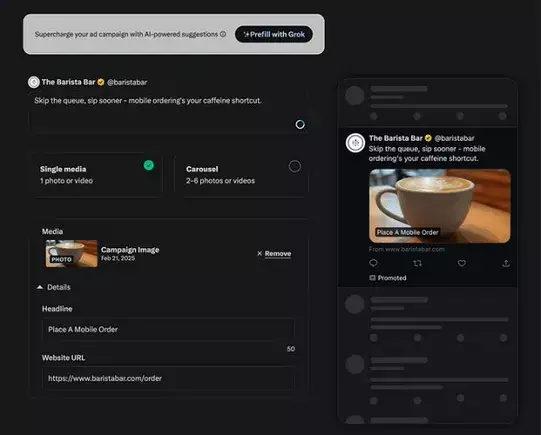In the ever-evolving landscape of digital marketing, artificial intelligence continues to redefine the way businesses approach advertising. X has recently launched its Grok 3 AI model, marking a significant advance in automated ad creation technology. This model is not merely a tech upgrade; it represents a fundamental shift in how advertisers can leverage AI to enhance their creative strategies and target audiences more effectively.
New Features: “Prefill with Grok” and “Analyze Campaign with Grok”
One of the standout features introduced alongside Grok 3 is “Prefill with Grok.” This tool simplifies ad creation by allowing advertisers to input a URL, from which Grok generates tailored ad copy, relevant imagery, and compelling calls-to-action (CTAs). This innovation is particularly beneficial for businesses that may lack the resources or expertise to craft engaging advertisements. By streamlining the ad creation process, X is positioning itself as a viable alternative to established players like Google and Meta, who have offered similar functionalities. However, the real challenge lies in how effectively Grok 3 can deliver superior results compared to its competitors.
The second feature, “Analyze Campaign with Grok,” invites a more analytical approach to advertising. This tool harnesses the power of Grok’s AI to provide actionable insights into ad performance, allowing advertisers to refine their strategies in real-time. By identifying trends and uncovering hidden opportunities, this feature empowers users to make data-driven decisions that could significantly enhance the efficacy of their advertising efforts. The ability to optimize ads swiftly based on intelligent feedback represents a leap forward in the integration of AI into marketing processes.
Evaluating the Impact of AI in Advertising
While these advancements are promising, the effectiveness of such tools in achieving meaningful results remains to be seen. Initial phases of implementation may yield mixed outcomes, as advertisers adjust to the AI’s recommendations and adapt their content accordingly. As X touts Grok as “the smartest AI in the world,” stakeholders are left to wonder how well it will stand up against the dynamic expectations of digital advertising.
The ultimate success of these tools will depend on their ability to deliver measurable performance improvements. Advertisers must weigh the potential benefits of adopting these AI-driven features against the initial investment in time and resources necessary to integrate them into their strategies. Moreover, as these tools are rolled out in phases, their reach is initially limited, which may hinder widespread adoption among advertisers eager to innovate.
X’s introduction of Grok 3 and its associated features signals a promising future for the integration of AI in advertising. As businesses increasingly turn to technology to navigate the complexities of their marketing efforts, tools like “Prefill with Grok” and “Analyze Campaign with Grok” could play a crucial role in shaping campaign strategies. However, the real test will be in their practical application and the tangible results they can produce. For advertisers willing to embrace this technological evolution, the potential for enhanced creativity and deeper audience engagement is significant. With continued advancements, the marketing landscape could very well be transformed through the intelligent application of AI.


Leave a Reply